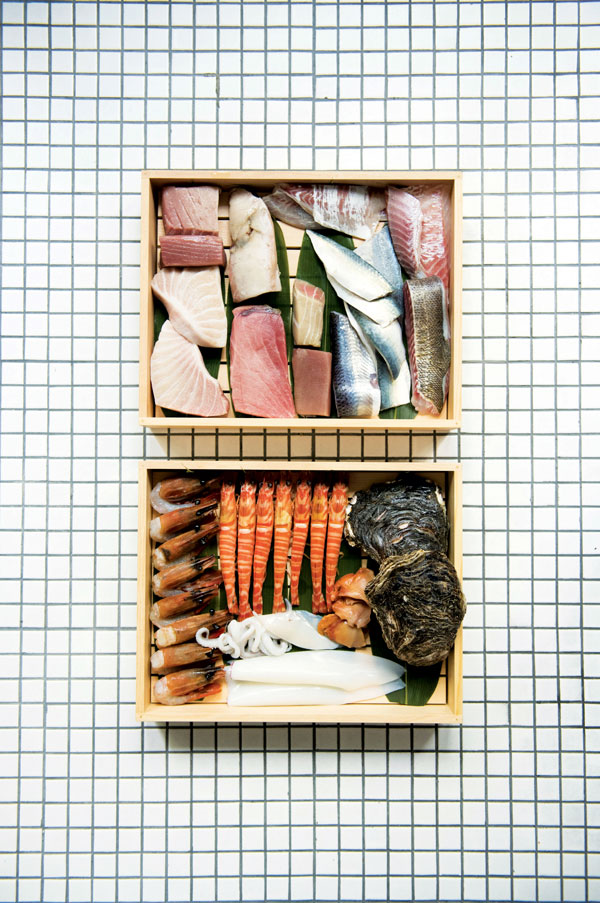
In the best sushi restaurants, the itamae, or chefs, have a secret. You know that tuna you love, so fresh it was swimming in the sea this morning? Well, it’s somewhere in the back, ageing, and you’re not going to taste it for days or even weeks. As the flesh of fish ages, enzymes break down the proteins and fats, enhancing the flavour and improving the texture. In Hong Kong, an unlikely figure leads the movement that advocates ageing fish, American Chef Max Levy.
If the idea of ageing fish gives you pause, consider that it’s a process that has been followed in various ways for centuries in many cultures. Hong Kong is famed for its dried seafood. Fermentation is favoured in the Nordic countries. Smoking and salt-curing are common in many parts of the world. And you’ll be hard-pressed to find a brunch spread that fails to serve gravlax: thinly sliced, cured salmon.
At his two casual izakaya, Okra Hong Kong and Okra 1949 in Beijing, Levy prefers to dry-age his fish. The young native of New Orleans taught himself how to do it. He experimented first with the more common process of ageing beef. “When I first went to Beijing, everyone said Chinese beef was terrible,” Levy says. “I went to a few cattle farms and saw that the beef wasn’t that bad. It was really about how it was being treated after. We started dry-ageing the Chinese product and it got to a point where the so-called substandard Chinese beef was tasting better than the imported stuff.”

Inspired, Levy turned his hand to ageing fish. The flavour of fish, he noticed, was far less intense outside Japan, where dry-ageing is common. “When I first started working in sushi restaurants, the fish was really strong, not like the dock area or the sea, but really strong fish,” he says. “Because there was only one flight a week, you’d often be getting tuna that was three weeks out of the water and that was considered normal. Now you get fish that shows up the same day it’s caught and it’s so fresh that the meat is still hard and there’s no flavour.”
To enhance the taste, Levy dry-ages the fish, activating the natural enzymes present, and so changing the flesh chemically while avoiding drying it out. “You lose a lot with evaporation,” he says. He estimates that evaporation reduces the volume of a fish by 30 per cent. “But what you lose in volume, you gain in density and flavour.”
Dry-ageing is an art rather than a science. No formulae are available. It requires patience and a clean place with a controlled environment to do it perfectly. “If you understand food poisoning and bacteria, then the main thing you need to do is keep a clean environment,” Levy says.
Levy checks on his ageing fish every day, tasting samples so he can gauge its progress and judge when best to serve it. “Today, maybe it will be good with soy sauce, tomorrow maybe with salt and lemon juice, and at the end of the week I can serve it with nothing,” he says. “If I can serve you something that doesn’t need any condiments, that’s the goal.”

The effect of ageing on the fish is pronounced and sometimes too intense for the average diner, as its taste can be up to 20 times stronger than that of fresh fish. The time Levy takes to age a piece of fish varies, depending on the species, the cut and what the flesh will be used for, but he rarely ages it for longer than three weeks. In contrast, Sukiyabashi Jiro, the famed restaurant in the Ginza district of Tokyo owned by chef Jiro Ono, ages its fish for no longer than 10 days, according to the documentary film Jiro Dreams of Sushi.
“Have you ever had chūtoro?” Levy asks, referring to the highly prized cuts of fatty tuna from the fish’s underbelly. “Sometimes you get it, and you’re chewing on it, and it’s just water coming out. It’s not pleasant, but you paid a lot of money for it, so you’re not going to let yourself think it’s bad. When you age that fish, even for five days, the collagen gets broken down into sugars and amino acids, so the meat becomes firmer but the fat and collagen become softer and sweeter. It’s a very different fish.”
Levy is well aware of the public bias against ageing fish. Often, to avert a fruitless conversation, he avoids discussing the subject with diners. “People say, ‘Oh, wow. Your fish is so fresh.’ And I’ll just be, like, OK. For me, part of my job is to judge the individual customers. Some people will get it, and they’ll listen to you. Others, if you tell them, they’ll get turned off and they don’t want to hear it, especially from a white guy.”
Those that get it and listen to Levy relish the taste and they’re willing to pay handsomely for it.
This article originally appeared in the July 2017 issue of #legend magazine.





